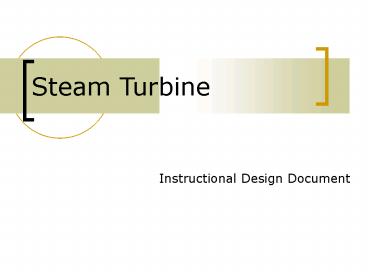IDD Steam Turbine PowerPoint PPT Presentation
1 / 24
Title: IDD Steam Turbine
1
(No Transcript)
2
- To study and understand the process of steam flow
in impulse and reaction turbine. - To visualize the following for impulse steam
turbine. - Steam flow
- Expansion of steam in LP and HP stages
3
Steam turbine
- A steam turbine is a thermo-mechanical device
that extracts thermal energy from pressurized
steam, and converts it into rotary motion.
4
Steam
Steam is vapourized water. It is a transparent
gas. At standard temperature and pressure, pure
steam (unmixed with air, but in equilibrium with
liquid water) occupies about 1,600 times the
volume of an equal mass of liquid water.
Saturated steam is steam at equilibrium with
liquid water at the same pressure and
temperature. Superheated steam is steam at a
temperature higher than its boiling point at a
given pressure
5
Rankine Cycle
There are four processes in the Rankine cycle,
these states are identified by number in the
diagram to the right. Process 1-2 The working
fluid is pumped from low to high pressure, as the
fluid is a liquid at this stage the pump requires
little input energy. Process 2-3 The high
pressure liquid enters a boiler where it is
heated at constant pressure by an external heat
source to become dry saturated vapour. Process
3-4 The dry saturated vapour expands through a
turbine, generating power. This decreases the
temperature and pressure of the vapour, and some
condensation may occur. Process 4-1 The wet
vapour then enters a condenser where it is
condensed at a constant pressure and temperature
to become a saturated liquid. The pressure and
temperature of the condenser is fixed by the
temperature of the cooling coils as the fluid is
undergoing a phase-change.
6
T- s Diagram
7
Impulse Reaction turbines
- An impulse turbine has fixed nozzles that orient
the steam flow into high speed jets. - These jets contain significant kinetic energy,
which the rotor blades, shaped like buckets,
convert into shaft rotation as the steam jet
changes direction. - A pressure drop occurs across only the stationary
blades, with a net increase in steam velocity
across the stage.
8
Reaction turbine
In the reaction turbine, the rotor blades
themselves are arranged to form convergent
nozzles. This type of turbine also makes use of
the reaction force produced as the steam
accelerates through the nozzles formed by the
rotor. Steam is directed onto the rotor by the
fixed vanes of the stator. It leaves the stator
as a jet that fills the entire circumference of
the rotor. The steam then changes direction and
increases its speed relative to the speed of the
blades. A pressure drop occurs across both the
stator and the rotor, with steam accelerating
through the stator and decelerating through the
rotor, with no net change in steam velocity
across the stage but with a decrease in both
pressure and temperature, reflecting the work
performed in the driving of the rotor.
9
Working of steam turbine based power plant
10
Working
- Steam is generated in steam generator and
supplied to steam turbine at high pressure.
(Usually sub critical pressure) - This steam enters the high pressure rotor and
expands , to produce work. - Low pressure turbine stage is provided to extract
more amount of work from the steam leaving into
the condenser.
11
Steam turbine Blades
- Steam turbine blades are subjected to high
thermal stresses. - They are made of Ni-chrome steel.
12
Stator Rotor
- Steam enters in the stator and then enters into
the rotor. - The pressure drop occurs in stator for impulse
turbines where as for reaction turbines pressure
drop occurs in both stator and rotor. - Work is produced in the rotor by the steam
because of a reduction in its pressure(reaction
turbine) and a change in the direction of its
velocity (reaction and impulse turbines).
13
Velocity triangles
- Steam enters axially and leaves axially.
(generally in axial-flow steam turbines)
14
The velocity of the fluid approaching the bucket
Vai .The velocity of the bucket U.The
velocity of the approaching fluid to relative the
bucket velocity is Vri Vai - UThe velocity of
the outlet fluid relative the bucket velocity is
Vre k(Vri) (k being a friction loss factor)The
velocity of the fluid in the direction of bucket
movement -gt is the whirl velocity. The outlet
whirl velocity Vae is simply given by, Vae U -
Vre(cos (p - ?)
15
Work Done / kg of steam
Work done / kg of steam is called specific work
out put of turbine. W.D/kg U (Vai Vae) U
Blade Velocity Vai Whirl velocity at inlet Vae
Whirl velocity at outlet Power output Ms U
(Vai Vae) Ms Mass flow rate of steam in
kg/s ? Q Where ? density (kg/m3) and Q
Volume flow rate (m3 /s).
16
User interface For simulation of Steam turbine
17
Operation 1
18
Operation 2
Reference http//atd.na.amec.com/flash_power.htm
l
19
Operation 3
20
- Refer excel sheet for calculations
21
Pressure drop occurs in which part in reaction
turbine
Stator only
Rotor only
Stator and Rotor
Nozzles and Rotor
22
- If shaft rotates in clockwise sense in
reaction turbine then casing will rotate in - same direction
- Does not rotate
- Opposite direction
- Both clock and counter clock direction.
23
- Steam flow in impulse steam Turbine is as follows
- Expands in nozzle, expands in stator, expands in
rotor and leaves the system. - Expands in nozzle, expands in stator, pressure
drop remains constant in rotor and leaves the
system. - Expands in Stator and does not expand in rotor
assembly. - Expands in rotor and does not expands in stator.
24
References
- Reference links
- http//atd.na.amec.com/flash_power.html
- http//www.cf.missouri.edu/energy/em_fun/flash/tur
bine.swf - http//web.iitd.ac.in/pmvs/jgl710/jgl710-26.ppt
- http//www.roymech.co.uk/Related/Fluids/Fluids_Mac
hines.html - Books
- Turbomachines by R. Yadav
- Fans compressors and turbines by SM Yahya

